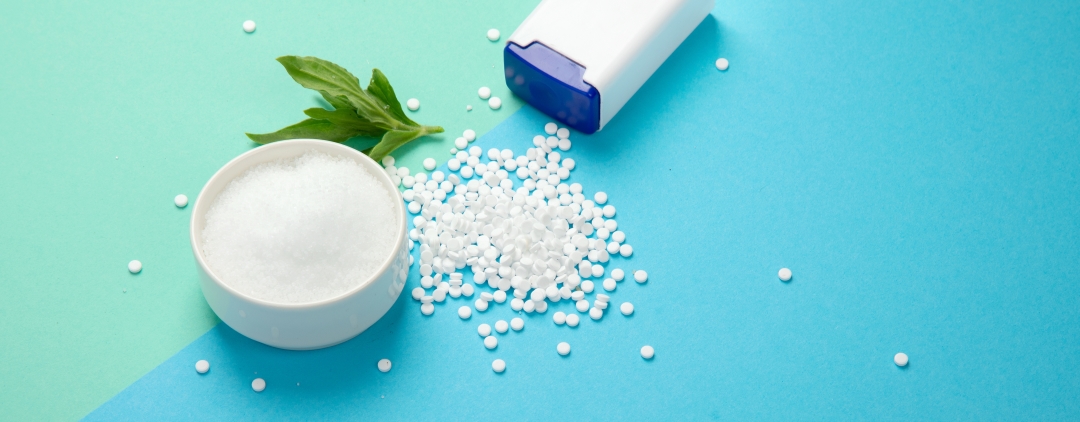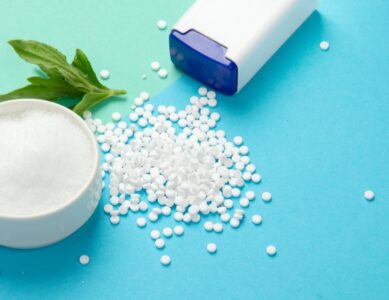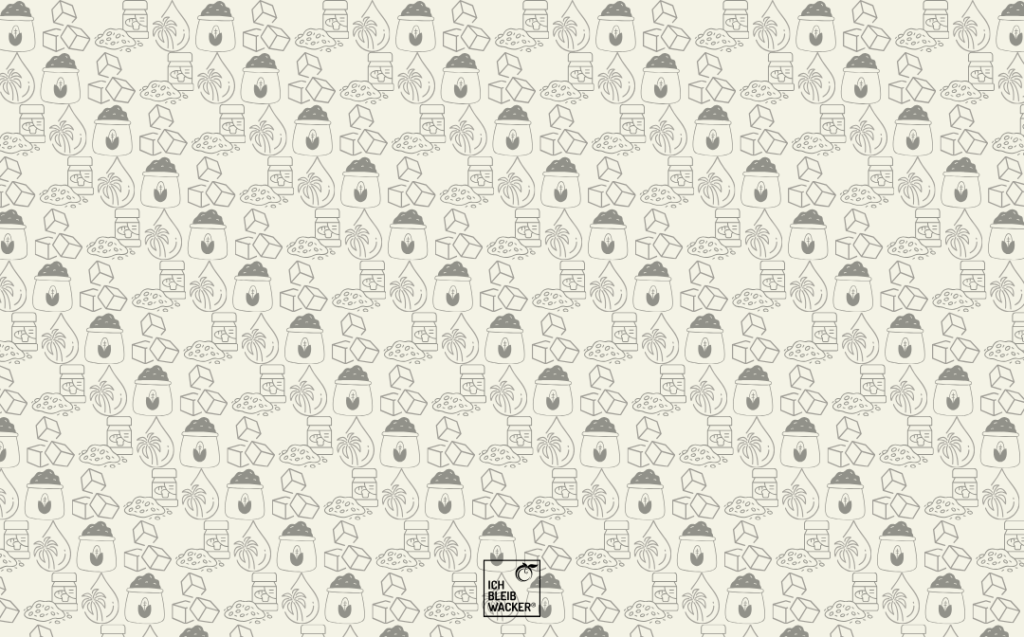Table of contents:
- Introduction: Sweeteners
- What is sucralose?
- Use of sucralose in food
- Effects on health
- Alternatives to sucralose: Natural sweetener
- Conclusion and recommendation
1. introduction: sweeteners
A basic distinction is made between sweeteners and sugar substitutes. Sweeteners are classed as additives and must therefore be listed in the list of ingredients on packaging with their class name and designation or E number. Although sugar substitutes provide fewer calories than sugar, in large quantities they have a laxative effect and cause diarrhoea.
You've probably come across the term "sucralose", or E955, whether you're shopping in the supermarket or looking for healthy alternatives to sugar. From soft drinks to chewing gum to baked goods, sucralose is often used as a sugar substitute to make food sweeter. In a world where we are increasingly looking for ways to improve our diets without sacrificing the pleasures of life, sucralose has become a term that promises hope: the sweetness we love without the remorse that often comes with it. But what exactly is sucralose and where is it to be found? Many manufacturers advertise the supposed harmlessness of sucralose, but is this really the case?
2 What is sucralose?
Sucralose is not a compound that occurs naturally. It is an artificial sweetener that has been used in food since the 1970s. The sweetener is produced from normal household sugar (sucrose) by replacing some hydroxyl groups with chlorine atoms. Sucralose is therefore also known as "chlorine sugar", as it is chemically a chlorinated form of household sugar. The process described makes sucralose around 600 times sweeter than conventional sugar. This means that you only need a tiny amount to sweeten your coffee or tea or to give your favourite dessert the perfect taste. As the body does not recognise sucralose as a carbohydrate, it is not broken down and therefore provides no calories. Sucralose is therefore a calorie-free sweetener, which makes it all the more attractive to many people.
The Federal Institute for Risk Assessment states that the maximum acceptable intake of sucralose is 15 mg per kilogramme of body weight.
3. use of sucralose in foods
Sweetening power and possible uses
With a sweetening power that is around 600 times stronger than that of conventional sugar, sucralose makes it possible to give foods and drinks an intense sweetness without adding calories. This property makes sucralose particularly attractive for the production of diet and light products and for people who want to reduce their sugar consumption without having to give up sweet flavours.
Sucralose can be found in a variety of foods and drinks. These include sugar-free or reduced-sugar soft drinks, but also chewing gum, jellies, breakfast cereals, confectionery and baked goods, spreads, sweet and sour fruit, vegetables or tinned fish. The sweetener is also authorised for use in protein bars and muesli bars, sauces, mustard, snacks made from cereals or nuts and food supplements. It is even found in some types of yoghurt and ice cream. Not forgetting the many diet products and supplements, including protein shakes and bars, which do not contain added sugar and are instead sweetened with sucralose to provide a low-calorie but still sweet alternative.
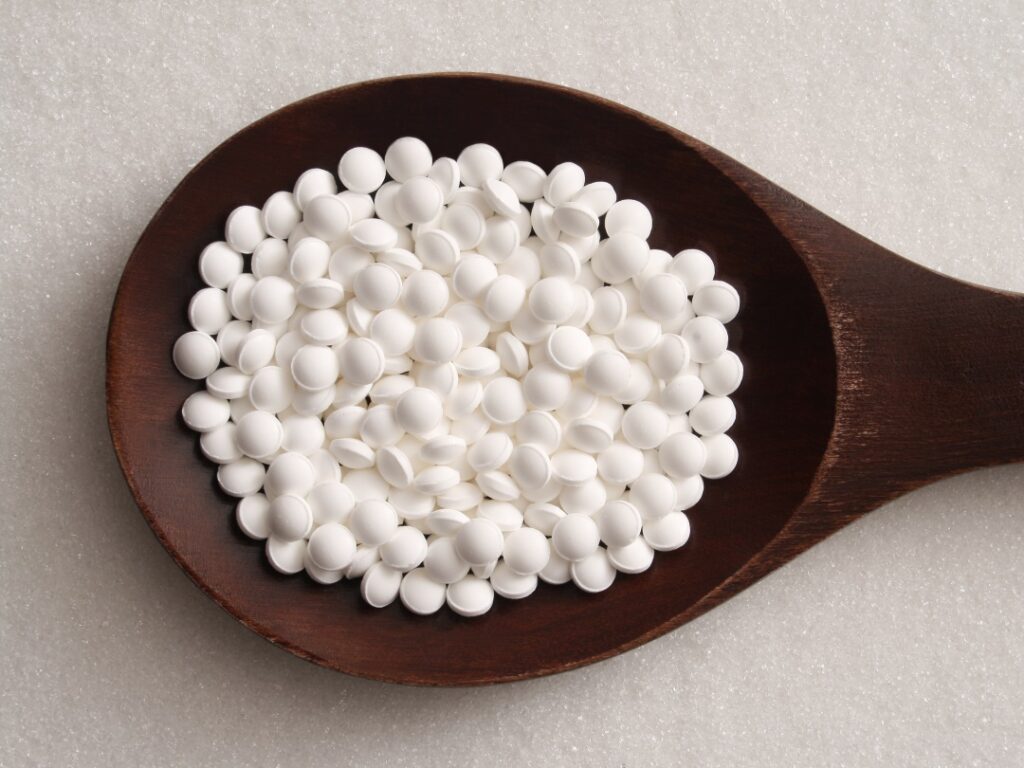
Advantages and disadvantages of sucralose compared to other sweeteners:
Advantages:
- Neutral flavour: Unlike other sweeteners, surcalose has no bitter aftertaste, which is why it is so popular in the beverage industry as a sweetener for calorie-free lemonades and energy drinks.
- Gentle on teeth: In contrast to conventional sugar, sweeteners such as sucralose do not cause tooth decay, so they are cariogenic because they are not metabolised by the bacteria in the mouth.
- Calorie-free: Sucralose is considered calorie-free because the human body does not metabolise it for the most part and it therefore provides no calories. This makes sucralose a popular choice for people who want to reduce their sugar intake without sacrificing sweetness.
Nevertheless, there is debate about the long-term effects of sucralose on health and the environment, with some studies showing potential negative effects.
Disadvantages:
- Heat-sensitive and carcinogenic: The Federal Food Safety and Veterinary Office (FSVO) writes: "If sucralose is heated to temperatures above 120 °C, compounds may be formed that could potentially be carcinogenic. This also applies to the heating of foods containing sucralose". This was shown by an evaluation by the Federal Institute for Risk Assessment (BfR) back in 2019. Even though the risk assessment has not yet been finalised, the FSVO recommends that, based on the findings already available, food containing sucralose should not be heated to temperatures above 120 °C or that sucralose should only be added after heating.
- Impact on the environment: Sucralose is not fully absorbed by the human body and is largely excreted unchanged. This means that a significant proportion of the sweetener ends up in the sewage system and ultimately in the environment. Sewage treatment plants find it very difficult to filter out the sweetener, which means that sucralose can remain in the groundwater for several years.
Effects on health
Studies on the safety of sucralose
Insulin resistance:
A study published in 2018 in the "American Journal of Clinical Nutrition", investigated the effects of sucralose on insulin sensitivity. The control study was conducted with healthy participants who do not normally consume artificial sweeteners. The participants received sucralose or a placebo daily for 14 days. Insulin sensitivity was assessed before and after the intervention period using an intravenous glucose tolerance test.
Conclusion: The study found that the group that consumed sucralose had higher insulin resistance, i.e. a decrease in insulin sensitivity, than the placebo group. This suggests that the consumption of sucralose may impair insulin sensitivity, which is a risk factor for the development of type 2 diabetes.
Intestinal microbiome:
The study, "Artificial sweeteners induce glucose intolerance by altering the gut microbiota" published in "Nature" in 2014, investigated how artificial sweeteners can affect glucose tolerance through changes in the gut microbiome. Participants, both mice and humans, were exposed to different doses of artificial sweeteners. It was found that the consumption of these sweeteners altered the composition and function of the gut microbiome, leading to glucose intolerance. These effects could be reduced by antibiotic treatment and transferred from the microbiota of sweetener consumers to germ-free mice by faecal transplantation.
The thesis was supported by a Further studypublished in September 2022. Here, 120 participants who had not previously consumed any sweeteners were divided into six groups. Over four weeks, they consumed saccharin, sucralose, aspartame, stevia or, as a comparison, glucose every day, while a control group received nothing. Despite adhering to the recommended limits, all sweetener groups showed microbiome changes, especially with saccharin and sucralose.
Conclusion: The results showed that sucralose causes significant changes in the gut microbiota even at doses equivalent to average human consumption levels. The participants who received saccharin and sucralose showed reduced sugar metabolisation and increased blood glucose levels, which could increase the risk of obesity and type 2 diabetes.
One In vitro study from 2021 has shown that the sweeteners saccharin, sucralose and aspartame can have negative effects on gut bacteria such as Escherichia coli and Enterococcus faecalis. These bacteria can penetrate the intestinal wall after ingesting the sweeteners, which can lead to infections if they enter the bloodstream and other organs. Even small amounts of these sweeteners, which can easily be ingested through the daily diet, are sufficient to significantly alter the intestinal flora.
While some research indicates potential risks, especially at high consumption levels, others emphasise the safety of sucralose within the intake limits set by regulatory authorities. The International Sweeteners Association (ISA), the US Food and Drug Administration (FDA), the European Food Safety Authority (EFSA) and other health organisations have classified sucralose as safe for human consumption as long as intake remains within recommended limits.

Risks for certain groups of people
People with a sensitive digestive system or existing digestive disorders: Some studies suggest that sucralose may affect the intestinal flora and cause digestive discomfort such as flatulence, diarrhoea or irritation in people with sensitive digestive systems.
People with insulin resistance or diabetes: Although sucralose is often advertised as a sugar-free alternative for diabetics, some research shows that sucralose may affect insulin and blood sugar levels. People who need to carefully monitor their blood sugar levels may therefore want to reconsider consuming sucralose and consult their doctor.
Pregnant women and breastfeeding mothers: As research into the long-term effects of sucralose is not yet conclusive, pregnant and breastfeeding mothers may want to limit their consumption as a precaution. It is always advisable to play it safe when it comes to nutrition during pregnancy and breastfeeding.
Children: Children may be more susceptible to the effects of additives, including sucralose, due to their lower body weight and developing bodies. Limiting artificial sweeteners in children may be a prudent measure until more is known about their long-term effects.
Alternatives to sucralose: Natural sweeteners
Date sugar: Also known as date sweetener, it is a natural alternative to sucralose and other artificial sweeteners. It is made from dried dates that are ground into a powder. Date sugar not only contains sugar, but also fibre, vitamins (such as vitamin B6 and K) and minerals (including potassium, magnesium and manganese) that come from the dates themselves. Although date sugar still contains sugar and should be consumed in moderation, it has a lower glycaemic index than refined sugar due to its natural fibre content. This means it can cause less of a spike in blood sugar levels. Although date sugar is more nutritious than refined sugar, it contains a similar amount of calories. It should therefore be used in moderation, especially for those who are watching their calorie intake.
Coconut blossom sugar: Coconut blossom sugar is also a popular natural alternative to sucralose and other artificial sweeteners. It is obtained from the nectar of the coconut palm blossom, which is collected, boiled down and processed into granules or syrup. Coconut blossom sugar has a slightly caramel-like flavour and can be used directly as a substitute for conventional sugar in many recipes. Coconut blossom sugar has a lower glycaemic index (GI) than conventional sugar. This means that it raises blood sugar levels more slowly, which can be beneficial for people with diabetes or those who want to control their blood sugar levels. However, the difference in GI between coconut blossom sugar and conventional sugar is not extreme, and coconut blossom sugar should still be consumed in moderation.
Honey: Honey is a natural sweetener that has been used for thousands of years. It contains antioxidants, vitamins and minerals that make it a healthier choice than refined sugar. However, honey does contain calories and can affect blood sugar levels, so it should be consumed in moderation. Excessive consumption can contribute to weight gain and an increased risk of type 2 diabetes and heart disease. People with pollen allergies should also be careful as honey may contain pollen.
Maple syrup: Maple syrup is another natural sweetener obtained from the sap of the maple tree. It contains antioxidants and minerals such as manganese and zinc. However, like honey, maple syrup also contains calories and sugar, so it should also be used in moderation. However, compared to refined sugar, maple syrup is rich in antioxidants and contains beneficial minerals.
Stevia: Stevia is a natural sweetener extracted from the leaves of the Stevia rebaudiana plant. It contains no calories and has a glycaemic index of zero, which means that it does not raise blood sugar levels. Stevia is a popular choice for diabetics and people who want to reduce their sugar intake. Pure stevia extracts are generally considered safe. However, some people report side effects such as bloating, nausea or a laxative effect. It is also important to be aware of products that contain stevia, as these may contain additional ingredients such as sugar alcohols or other fillers that are not suitable for everyone.
Erythritol: Erythritol belongs to the group of sugar alcohols and is a natural sweetener found in small amounts in fruit and vegetables. It has about 70% the sweetening power of sugar, but contains almost no calories and does not affect blood sugar levels, making it a good alternative for diabetics and people who want to watch their weight. As a sugar alcohol, erythritol can cause digestive problems such as flatulence, diarrhoea and abdominal pain in large quantities. However, most people tolerate erythritol better than other sugar alcohols because a large proportion is already absorbed in the small intestine and does not reach the large intestine, where most digestive problems occur.
Xylitol (xylitol): Xylitol is another sugar alcohol with a sweetening power very similar to that of sugar. It contains 40% fewer calories than sugar and has a low glycaemic index. One of the remarkable properties of xylitol is its dental health benefits; it reduces the risk of tooth decay and promotes dental health. Xylitol is known to cause digestive problems such as flatulence and diarrhoea in some people, especially in high doses. A very important warning applies to pet owners: xylitol is highly toxic to dogs and can be life-threatening even in small amounts.
Conclusion and recommendations: Stay sweet, but safe
Sucralose may be a calorie-free alternative to sugar, but the potential risks and side effects have many looking for safer and healthier options. For these reasons, many are turning to natural sweeteners such as stevia or erythritol. They offer a good alternative for those who want to reduce their sugar intake without jeopardising their health.
In order to make informed decisions about consuming sucralose, it is important to read food ingredient lists carefully. This is because sucralose is not only found in obvious products such as "sugar-free" foods, but also in processed products where you might not expect it. Rather than relying on sweeteners to reduce sugar consumption, a more comprehensive approach to dietary change can be helpful. This includes eating whole, unprocessed foods and focusing on natural sources of sweetness, such as those found in fruit.
While sucralose and other artificial sweeteners may seem to offer convenient alternatives to sugar, it is essential to be aware of the potential health risks and take a balanced, informed approach to nutrition. Ultimately, it is important to educate yourself about the ingredients in food and drink and make conscious choices that support your health.
The fruit bars and puffed snacks from Wacker offer a healthy and natural snack alternative - free from sucralose and other additives and industrially added sugar. Get the Organic snack pack and snack without a guilty conscience in future:
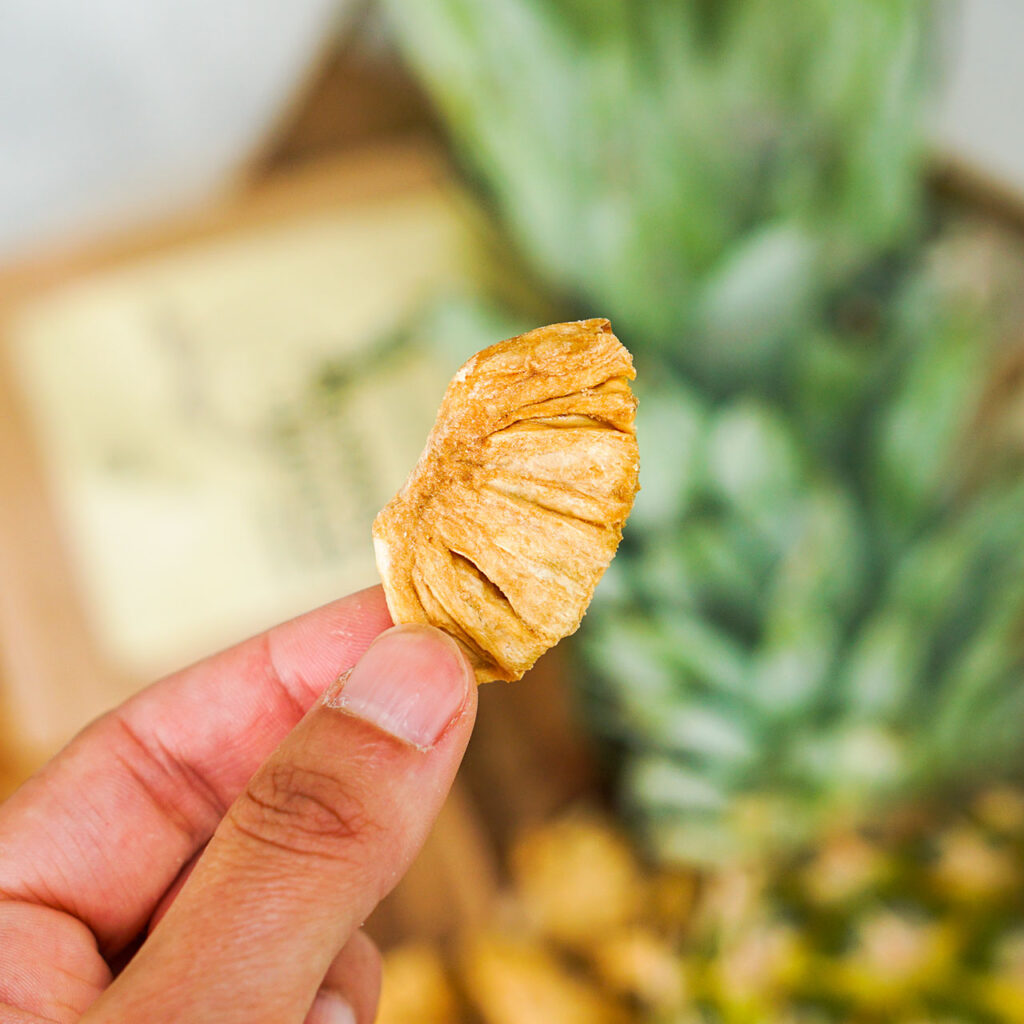
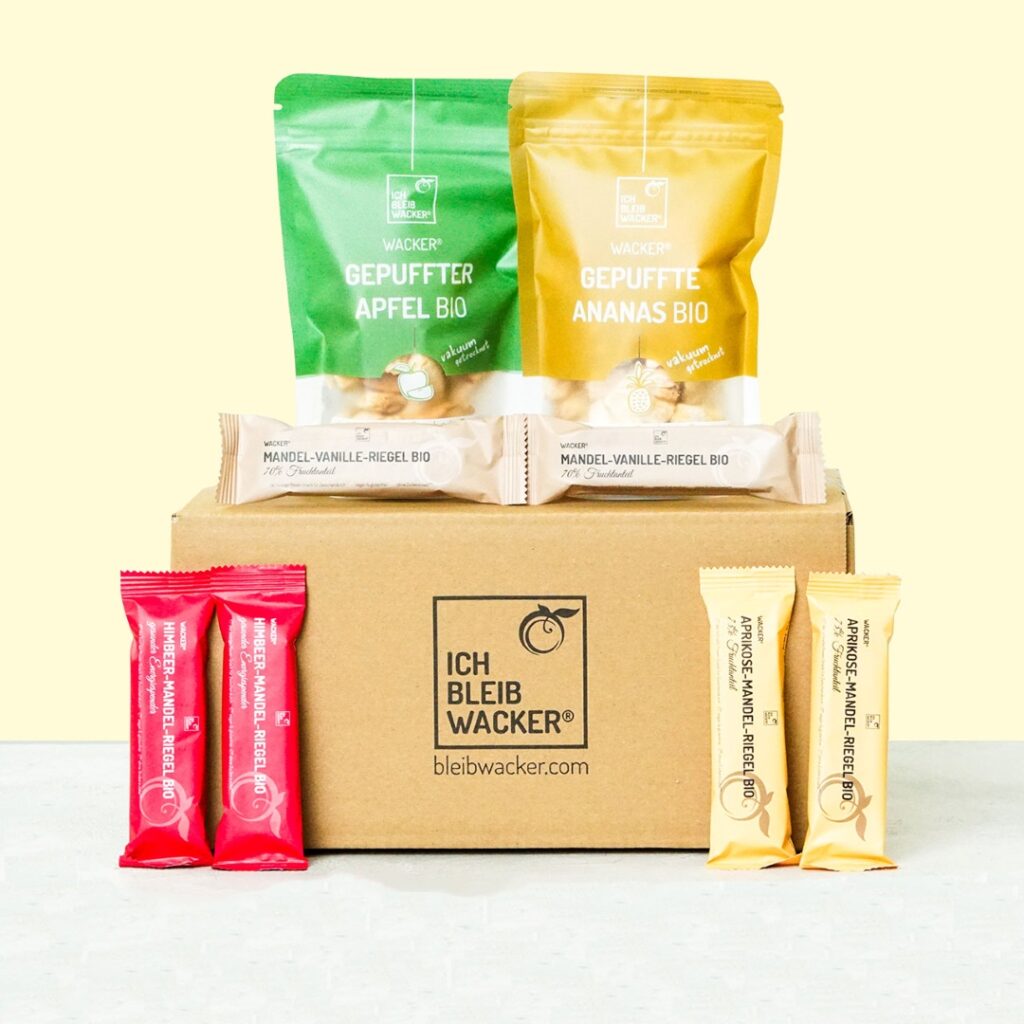
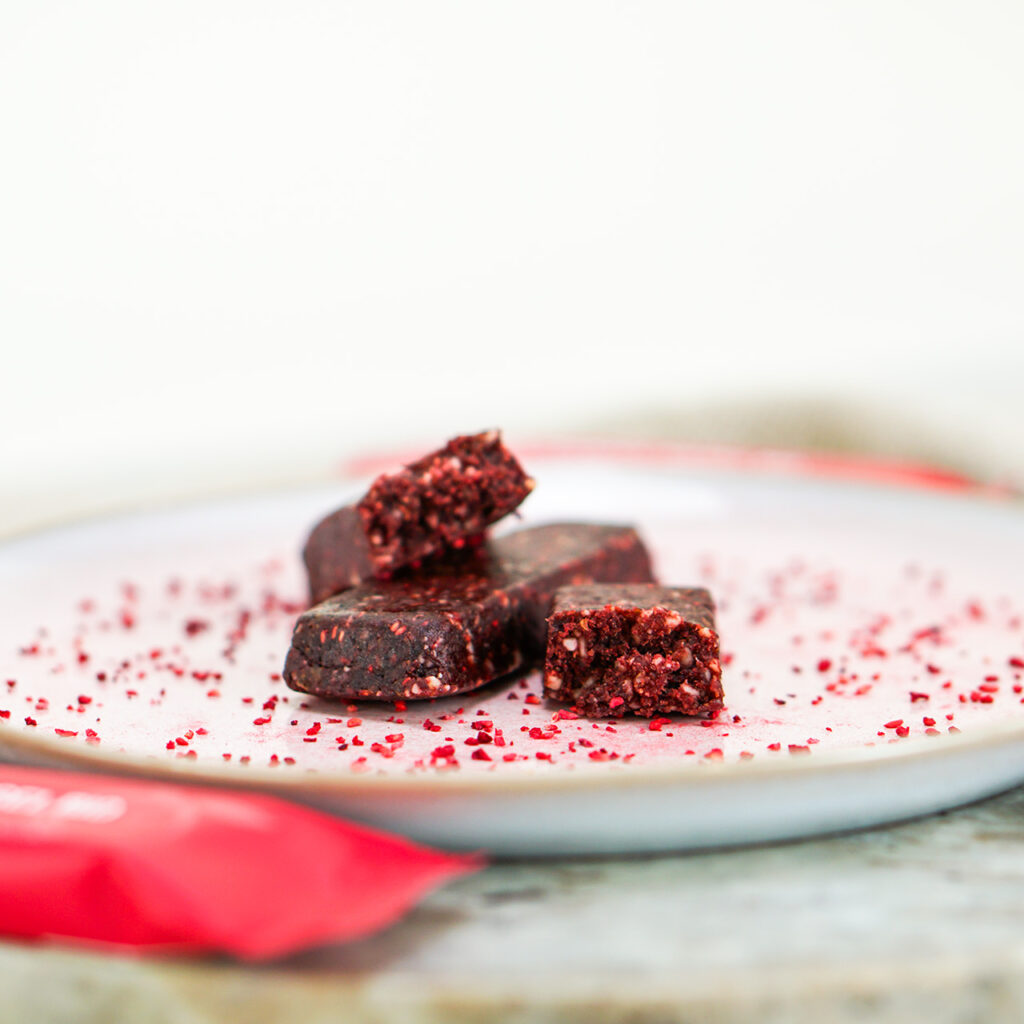
Why puffed is better? Find out here!
Sources: BLV, NDR, world, Utopia, Consumer advice centre
Photo sweetener sucralose: Adobe Stock, bit24, #518290772
Photo risk sucralose: Adobe Stock, Nuthawut, #500905880

